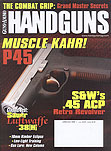
Kahr P45
Kahr goes bigbore as it continues to expand its line of compact autos.
HANDGUNS, June/July 2006 By Frank W. James
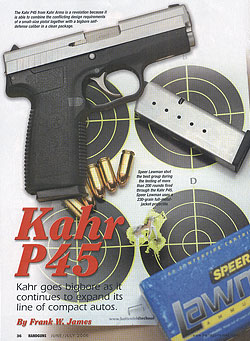 The Kahr P45 from Kahr Arms is a revelation because it is able to combine the conflicting design requirements of a small-size pistol together with a bigbore self-defense caliber in a clean package.
Speer Lawman shot the best group during the testing of more than 200 rounds fired through the Kahr P45. Speer Lawman uses a 230-grain full-metal-jacket projectile.
The Kahr P45 from Kahr Arms is a revelation because it is able to combine the conflicting design requirements of a small-size pistol together with a bigbore self-defense caliber in a clean package.
Speer Lawman shot the best group during the testing of more than 200 rounds fired through the Kahr P45. Speer Lawman uses a 230-grain full-metal-jacket projectile.
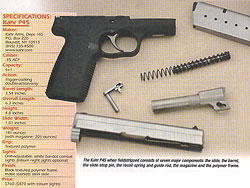 The Kahr P45 when fieldstripped consists of seven major components: the slide, the barrel, the slide-stop pin, the recoil spring and guide rod, the magazine and the polymer frame.
The Kahr P45 when fieldstripped consists of seven major components: the slide, the barrel, the slide-stop pin, the recoil spring and guide rod, the magazine and the polymer frame.
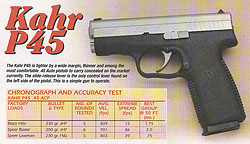 The Kahr P45 is lighter by a wide margin, thinner and among the most comfortable .45 Auto pistols to carry concealed on the market currently. The slide-release lever is the only control lever found on the left side of the pistol. This is a simple gun to operate.
The Kahr P45 is lighter by a wide margin, thinner and among the most comfortable .45 Auto pistols to carry concealed on the market currently. The slide-release lever is the only control lever found on the left side of the pistol. This is a simple gun to operate.Manufacturers of self-defense pistols have always struggled with conflicting design requirements. Creating a small pistol for a bigbore caliber has never been easy. The smaller the pistol, the easier it is to carry and conceal. But generally speaking, the more successful designs have also been made in a variety of small calibers. There are more than a few who disagree with the latter aspect of these guns and absolutely demand a bigbore diameter because, after all, these things aren't being carried as a fashion statement. They are carried for a purpose, and big calibers generally work better at this purpose than smaller calibers.
So, what to do about these dilemmas?
Well, if you're Justin Moon of Kahr Arms you design a .45-caliber semiauto pistol that's based upon your highly successful 9x19mm and .40 S&W semiautos, and you call it the P45.
The gun is a revelation. It is not a reinvented cut-down, "I hope it works," super-short, radical modification of the venerable 1911 pistol, which has been the vehicle for most of these .45-caliber exercises in the past. Nope, not at all; this gun is a continuation of the brilliant Kahr design. But here Kahr has achieved what many thought impossible. Its size in terms of height and length is not extraordinary, but it is lighter by a wide margin, thinner and among the most comfortable .45 Auto pistols on the market.
Kahr handguns are all characterized by a double-action-only trigger action that is both smooth and easy to operate. All are relatively slim guns, and they have all established a good reputation for reliability, but designing one in .45 ACP caliber would be something only a few would attempt.
Before getting into the actual dimensions of this new self-defense .45 Auto, let's examine its main characteristics. As mentioned, it is a DAO pistol like all the other products in the Kahr line. It utilizes a polymer frame with two short but thick steel pads at the rear of its polymer receiver to carry the slide and two much longer rails located lower in the dustcover portion of the polymer frame to carry the front of the slide. This is a distinct departure from most every other polymer design. Just about everyone else uses four equal-size steel pads at the same relative height to carry the slide.
The operating system involves a Browning-style dropping-barrel design that is activated by a cam slot located under the chamber portion of the barrel. The cam slot operates via the slide-stop pin to drop the barrel once the pressure lowers in the chamber. The recoil spring is free. That is, it is not a captured design; and the recoil-spring guide is steel as opposed to polymer. The rear portion of the cam lug under the barrel also serves as the feed ramp, but here it is positioned slightly off center to the gun's left because space comes at a premium. Some space must be reserved for the double-action drawbar found on the right side of the polymer receiver, but not to worry: The polymer frame is molded in such a way as to fill the space to the right of the feed ramp, as well as protect the trigger drawbar just beneath it. Like all Kahr pistols, the P45 uses a striker-fired mechanism located in the slide, and it works off the DAO trigger.
The stainless steel barrel is 3.54 inches long and features a one-turn-in-16.38-inches right-hand twist rate. It locks to the slide via the front edge of the ejection port not through use of separate barrel-lug or matching recesses inside the top of the slide.
In terms of actual physical dimensions, the P45 is close but still smaller than the traditional cut down 1911 variant if only by the smallest of margins. The Kahr P45 had a slide length of 6.024 inches, while the oldest of the 1911 variants (my personal Colt Officer's Model) measures close to 6-1/4 inches, and that doesn't include the extra length provided the hammer spur or even the abbreviated grip safety on the Officer's Model. The overall length of the P45 is listed as 6.4 inches, but that's because the muzzle of the barrel protrudes slightly from the front of the slide and the rear portion of the polymer grip extends beyond the rear of the slide.
In terms of its height, as measured from the top of the slide to the bottom of the grip or the magazine, the Kahr P45 is actually a little taller than the Officer's Model by about two-tenths of an inch. However, this is a little misleading because the P45 magazine uses a plastic baseplate that also acts as a bumper pad during the reload and does not fit flush against the bottom of the polymer grip. The magazines for each gun, the new Kahr and the older Colt design, sport the same capacity: six rounds.
The Officer's Model has a little thinner slide than the Kahr by approximately .08 inch, which isn't much in the overall scheme of things, There is no comparison in the thickness of the respective grips. The Kahr P45 measures only .987 inch. (The factory lists the slide thickness as 1.01 inches, but my caliber said .987 inch.) The older Officer's Model is more than a quarter-inch wider.
Comparing the weight between the two, the Kahr P45 wins hands down.
It weighs only 18-1/2 ounces, without the magazine, compared to the much heavier weight of the all-steel Officer's Model in the same condition.
 The rear sight is mounted to the slide via a significant dovetail. It is a single triangle-shaped rear blade with a wide U-notch and white rectangular block directly under the U-notch.
The rear sight is mounted to the slide via a significant dovetail. It is a single triangle-shaped rear blade with a wide U-notch and white rectangular block directly under the U-notch.
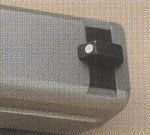 The top of the slide is well rounded on its top outside edges, and the front sight is secured to the slide via a dovetail. It consists of a single black blade with a white dot in the rear center of the blade.
The top of the slide is well rounded on its top outside edges, and the front sight is secured to the slide via a dovetail. It consists of a single black blade with a white dot in the rear center of the blade.
 Due to the size of the ejection port, the extractor must function perfectly in order to extract and eject a loaded round during a clearance drill because the port is shorter than the loaded round. The functioning was flawless during the author's testing.
Due to the size of the ejection port, the extractor must function perfectly in order to extract and eject a loaded round during a clearance drill because the port is shorter than the loaded round. The functioning was flawless during the author's testing.
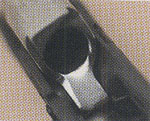 The feed ramp on the P45 is positioned slightly off center to the gun's left. The polymer frame is molded in such a way as to fill the space to the right of the feed ramp, as well as protect the trigger drawbar just beneath it.
The feed ramp on the P45 is positioned slightly off center to the gun's left. The polymer frame is molded in such a way as to fill the space to the right of the feed ramp, as well as protect the trigger drawbar just beneath it.The weight advantage is achieved through the use of a well-designed polymer frame, but the frame also seems to cushion the felt recoil. Admittedly, this is a subjective evaluation, one each shooter will have to determine on a personal basis, but I found the Kahr easier to shoot over a long string of fire than any comparable carbon-steel semiauto pistol.
It is the thinness and the lighter weight of this design that create an overall package that leaves one impressed, even if some aspects of its overall size are comparable to previously seen designs. The P45 is an extremely user-friendly package for just about everyone except those with fists the size of a canned ham. It would seem an especially good choice for the ladies interested in a lightweight, easy-to-carry self-defense pistol in a serious fighting caliber. Its overall size, shape and balance are real achievements.
As with all previously seen examples from the Kahr product line, the P45 has no restrike capability. That means if the chambered round doesn't fire, the operator must cycle the slide to extract and expel the chambered round and chamber a fresh round. (The idea is that the operator should not waste time trying to get a round hit once already with the striker to fire with a second strike of the striker assembly. Just get rid of it.)
While this is sound logic, it also requires extensive training on the part of the operator to guarantee a timely response to the situation surrounding the malfunction. In plain language, learn to keep the gun working even when it is fed bad ammunition.
The easiest way to achieve this is the infamous "screw your buddy" drill. Whenever you and a friend or duty partner are practicing together, exchange empty magazines together with a quantity of loaded rounds, as well as several spent cases. Each of you should load the other's magazine randomly with live rounds interspersed with empty cases. The drill is to reengage whatever target both of you are shooting and then see how quickly you react when the gun goes click instead of bang. The spent cases should chamber without the operator noticing their presence until the gun fails to fire. Even if they don't, the resulting malfunction is always a good educational tool for clearing malfunctions under stress. Once an operator gets the malfunction-clearance drills and the recharging of the chamber down to instinctive reaction, he is ready to use this pistol – or any other, for that matter, that offers no restrike capability in its operating design.
The Kahr P45 is obviously designed to be carried close because it lacks the usual sharp edges found all too often on other handguns. The stainless steel slide is well rounded on its top outside edges, and the front and rear corners of the slide are beveled as well. The front sight is secured to the slide via a substantial dovetail and consists of a black blade with a single white dot in the center. The rear sight is also mounted via a significant dovetail. It has a single triangle-shaped rear blade with a wide U-notch and a white rectangular block directly under the U-notch. Kahr also offers as an option tritium-powered front and rear sights for those wanting an advantage in aiming under low-light conditions.
| CHRONOGRAPH AND ACCURACY TEST Kahr P45 .45 ACP | ||||||||
|---|---|---|---|---|---|---|---|---|
| FACTORY LOADS | BULLET & TYPE | NO. OF ROUNDS TESTED | AVE. VEL. (fps) | EXTREME SPREAD (fps) | BEST GROUP @ 50 FT. (ins.) | |||
| Black Hills | 230 gr. JHP | 5 | 809 | 15 | 1.75 | |||
| Speer Blazer | 200 gr. JHP | 6 | 901 | 86 | 2.0 | |||
| Speer Lawman | 230 gr. FMJ | 5 | 803 | 39 | 0.75 | |||
The polymer frame carries the serial number on a metal tag molded into the polymer just in front of the triggerguard. The triggerguard, while ample in size, is not intended for use with a gloved hand. The smooth trigger face together with the P45's double-action pull weight of just more than eight pounds make this an easy pistol to shoot well. In fact, if there is one word to describe the P45, it would have to be "comfortable."
But I want to emphasize that it is the carrying I am classifying as such. Shooting the P45 is not extremely painful or burdensome, but there is a small problem with the trigger finger being struck by the inside of the triggerguard as the gun moves during recoil. It is sharp enough to be distracting and does lessen the overall enjoyment found with shooting this lightweight wonder. It should not be put into the same category as some rare-earth lightweight-alloy revolvers fired with .357 Magnum ammo, but the trigger-finger slap is noticeable. It is not a pistol I would recommend for a week of training that would consume a high round count on the square range of instruction. The gun would survive, but it's questionable if the shooter's trigger finger would in good order.
As for concealment, the Kahr P45 is an easy pistol to carry inside a front pocket of most any cargo-style casual slacks, but it is a little too large for the tight fit found on the front pockets of western-cut jeans. No attempt was made to find an ankle holster of suitable length to carry the P45, but it did work well with a universal pocket holster inside the front pocket of the author's trousers.
<< Go back to Previous Page